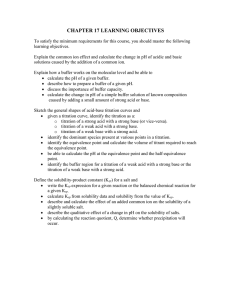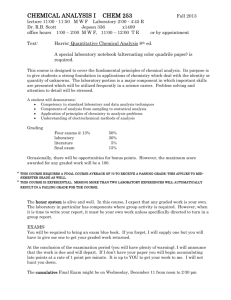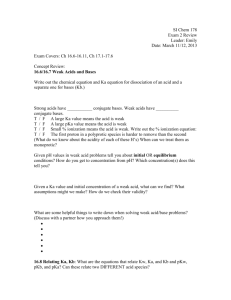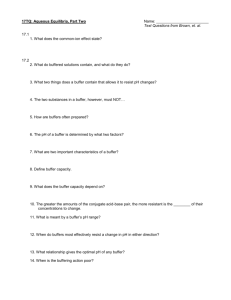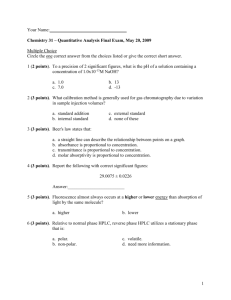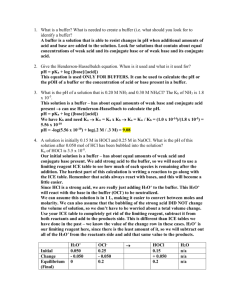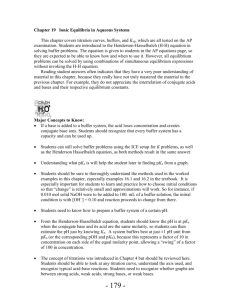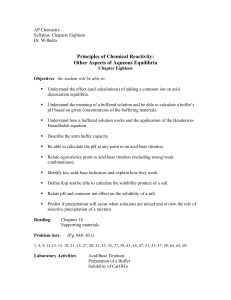Chemistry Midterm Exam: Buffers, Titrations, Kinetics
advertisement
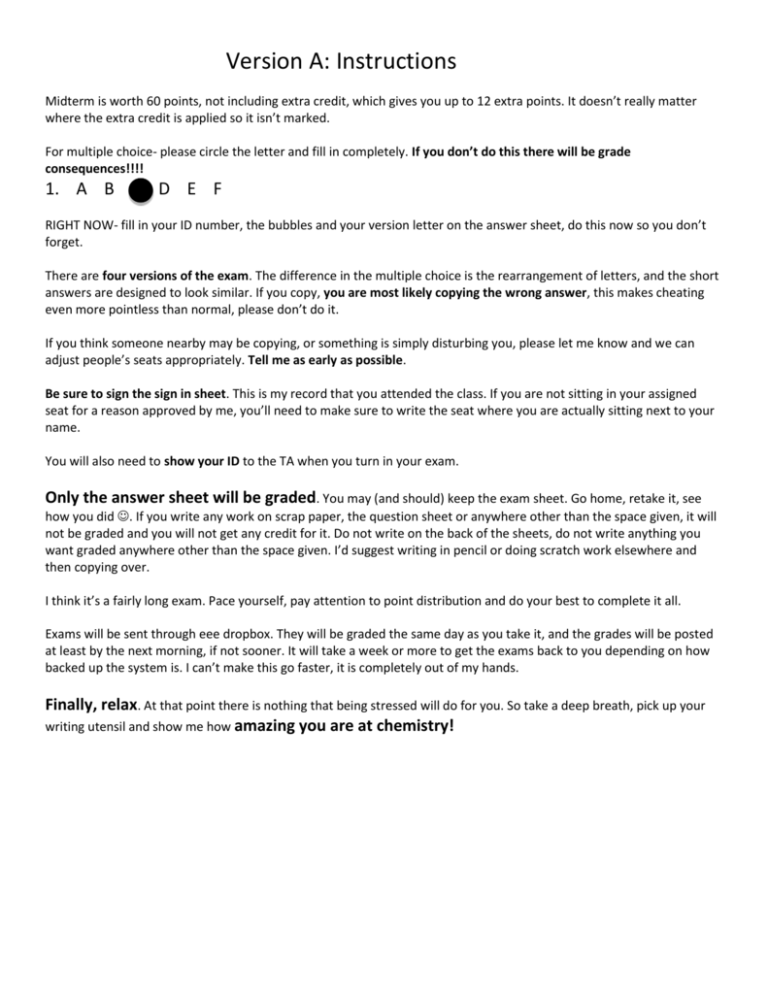
Version A: Instructions Midterm is worth 60 points, not including extra credit, which gives you up to 12 extra points. It doesn’t really matter where the extra credit is applied so it isn’t marked. For multiple choice- please circle the letter and fill in completely. If you don’t do this there will be grade consequences!!!! 1. A B C D E F RIGHT NOW- fill in your ID number, the bubbles and your version letter on the answer sheet, do this now so you don’t forget. There are four versions of the exam. The difference in the multiple choice is the rearrangement of letters, and the short answers are designed to look similar. If you copy, you are most likely copying the wrong answer, this makes cheating even more pointless than normal, please don’t do it. If you think someone nearby may be copying, or something is simply disturbing you, please let me know and we can adjust people’s seats appropriately. Tell me as early as possible. Be sure to sign the sign in sheet. This is my record that you attended the class. If you are not sitting in your assigned seat for a reason approved by me, you’ll need to make sure to write the seat where you are actually sitting next to your name. You will also need to show your ID to the TA when you turn in your exam. Only the answer sheet will be graded. You may (and should) keep the exam sheet. Go home, retake it, see how you did . If you write any work on scrap paper, the question sheet or anywhere other than the space given, it will not be graded and you will not get any credit for it. Do not write on the back of the sheets, do not write anything you want graded anywhere other than the space given. I’d suggest writing in pencil or doing scratch work elsewhere and then copying over. I think it’s a fairly long exam. Pace yourself, pay attention to point distribution and do your best to complete it all. Exams will be sent through eee dropbox. They will be graded the same day as you take it, and the grades will be posted at least by the next morning, if not sooner. It will take a week or more to get the exams back to you depending on how backed up the system is. I can’t make this go faster, it is completely out of my hands. Finally, relax. At that point there is nothing that being stressed will do for you. So take a deep breath, pick up your writing utensil and show me how amazing you are at chemistry! 1) Given that the ratio between [H2CO3] and [HCO3-] in a blood buffer system is 1:19, what is the pH and is the buffer better at buffering acid or base. Assume the pka of H2CO3 is 6.0. 7.27, acid 2) 100mL of each of the following are mixed; which one is a buffer? 1.0 M M NH3(aq) + 0.4 M HCl(aq) 3) A buffer contains equal concentrations of NH3 and NH4Cl. What is the pH of the buffer? (Kb(NH3)=1.8x10-5). 9.26 4) Calculate the ratio of the molarities of CO32- and HCO3- ions required to achieve buffering at pH=9.0. pKa1=6.37 and pKa2=10.00 for H2CO3 0.10 5) The curve for the titration of 50.0 mL of 0.0200M C6H5COOH (aq) with 0.100 M NaOH(aq) is given below. What are the main species in the solution after 7.5 mL of base have been added? (pka=4.202) C6H5COOH and C6H5COO6) What is the pH at the half equilibrium point from the titration of 0.22M HNO2 with 0.10M KOH? For HNO2, Ka=4.3x104 . 3.37 7) Which of the following indicators would be most suitable for the titration of lactic acid with a strong base. Lactic acid pKa=3.08. (Hints: Remember where a good indicator should switch colors in regards to the titrations pka, and where it does switch colors in regards to its pka) phenol red (pKIn = 7.9) The titration curve for the titration of 0.100 M Na2CO3 (aq) with 0.100 M HClO4 (aq) is below, use this to answer number 10 and 11: (hint: Careful this is a weak base titration and I’m asking you for the pKas) 8) Estimate the pKA2. 10.3 9) Estimate the pKA1. 6.4 10) What is the equation for Ksp for calcium phosphate? Ksp = 108s5 11) Calculate the solubility product of calcium hydroxide given that the solubility of Ca(OH)2(s) in water at 25oC is 0.011 M 5.3 x10-6 12) Calculate the solubility of BaF2 (ksp=1.84x10-7) in a 0.20M solution of F4.6x10-6 13) Calculate the solubility of BaF2 (ksp=1.84x10-7) in a 0.2M solution of Ba2+ 4.79x10-4 14) If 50.0 mL of 0.50 M NaCl(aq) is mixed with 50.0 mL of 0.50 M AgNO3(aq), What will be present in the beaker? Ksp(AgCl) = 1.6 × 10-10 NaNO3 (aq), AgCl(aq), AgCl(s) 15) In the reaction 3ClO-(aq)2Cl-(aq)+ClO3-(aq), the rate of formation of Cl- is 3.6 M/min. What is the rate of reaction of ClO-? 5.4 M/min 16) In the reaction 3ClO-(aq)2Cl-(aq)+ClO3-(aq), the rate of formation of Cl- is 3.6 M/min. What is the unique rate of the reaction? 1.8 M/min 17) NO reactions with hydrogen according to the following equation, the mechanism for the reaction involves the two steps shown below. What is the predicted rate law for the reaction? (hint: Be careful not to overcomplicate this one) rate=k[NO]2[H2] Short Answer 1 (4 points) The titration curve for the titration of 0.100 M H2SO3 (aq) with 0.100 M KOH(aq) is given below. Circle the region(s) where a good buffer is present (on answer sheet), state what specie(s) are present at each. (If there are multiple buffering regions be sure to clarify which specie(s) are present at which region.) First Region: H2SO3 and HSO3Second Region: HSO3- and SO32Short Answer 2 (5 points) In the titration of 0.300 M HCl(aq) with 0.300 M NaOH(aq), the equivalence point occurs at pH = 7 whereas in the titration of 0.300 M HCOOH(aq)(pka=3.77) with 0.300 M NaOH(aq) the stoichiometric point occurs at pH > 7. Explain. Then find the pH at the half equivalence point for HCOOH Short Answer 3 (3 points) What is the difference between molecularity and order? Molecularity refers to each step, order refers to the entire reaction, Molecularity is a theoretical concept while order is an experimental one. Short Answer 4 (4 points) Is a rate law for the following reaction that is first order in I- and second order in OCl- consistent with the mechanism shown below? If it is explain your reasoning, if it is not, give the rate law that is consistent. The complete reaction is as follows: The mechanism for the reaction above is as follows: Rate=k[I-][OCl-] Short Answer 5 (5 points) Use the following data to determine the rate law for the reaction between nitrogen oxide and chlorine to form nitrosyl chloride. Be sure to state what k is. Rate=117/sec*M2[NO]2[Cl] Short Answer 6 (4 points) Give three ways you can speed up a reaction, why do each of these work? Raise the temperature- increases the energy of molecules collisions and increases the number of collisions Increase the concentration- creates more collisions Use a catalyst- lowers the activation energy. Short Answer 7 (8 points) Balance the following redox reactions and decide which is the oxidizing agent and which is the reducing agent. A) Ag(s)+H2SO4(aq) Ag2SO4(aq)+SO2 (acidic solution) 2Ag(s)+2H2SO4(aq) Ag2SO4(aq)+SO2 +2H2O(acidic solution) Oxidizing agent- H2SO4 Reducing agent- Ag B) ZnS(s)+NO3-(aq) Zn2+ (aq)+S (s)+NO (basic solution) 4H2O+ 3ZnS(s)+2NO3-(aq)3 Zn2+ (aq)+3S (s)+2NO+8OH- (basic solution) Oxidizing agent- NO3Reducing agent- ZnS Scrap Paper: Don’t turn in- We will not under any circumstance grade this page. Transfer all needed work to answer sheet. Scrap paper: Do not turn in, do not put anything on here that you want us to grade, it is for your own personal use only. Scrap paper: Do not turn in, do not put anything on here that you want us to grade, it is for your own personal use only.

